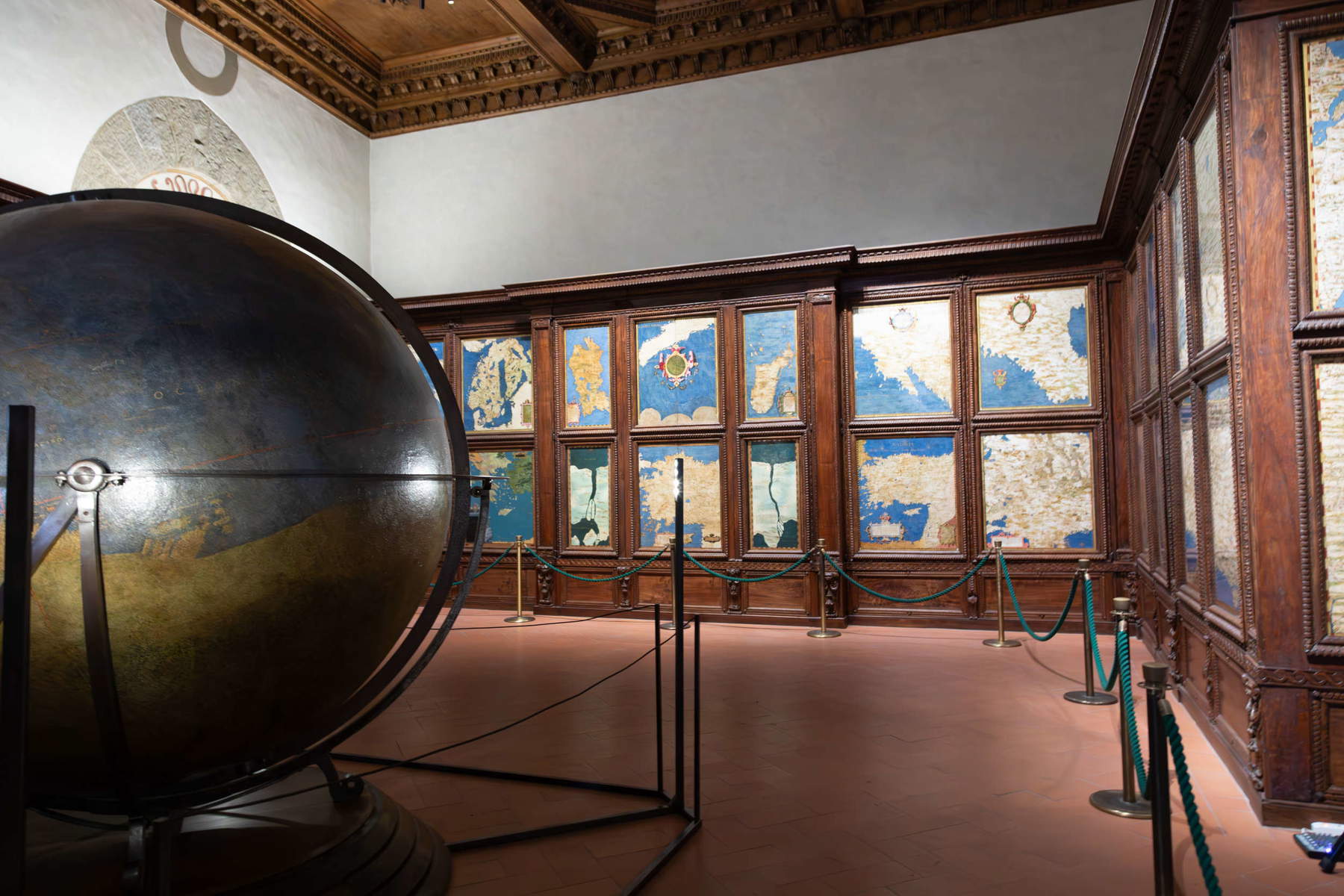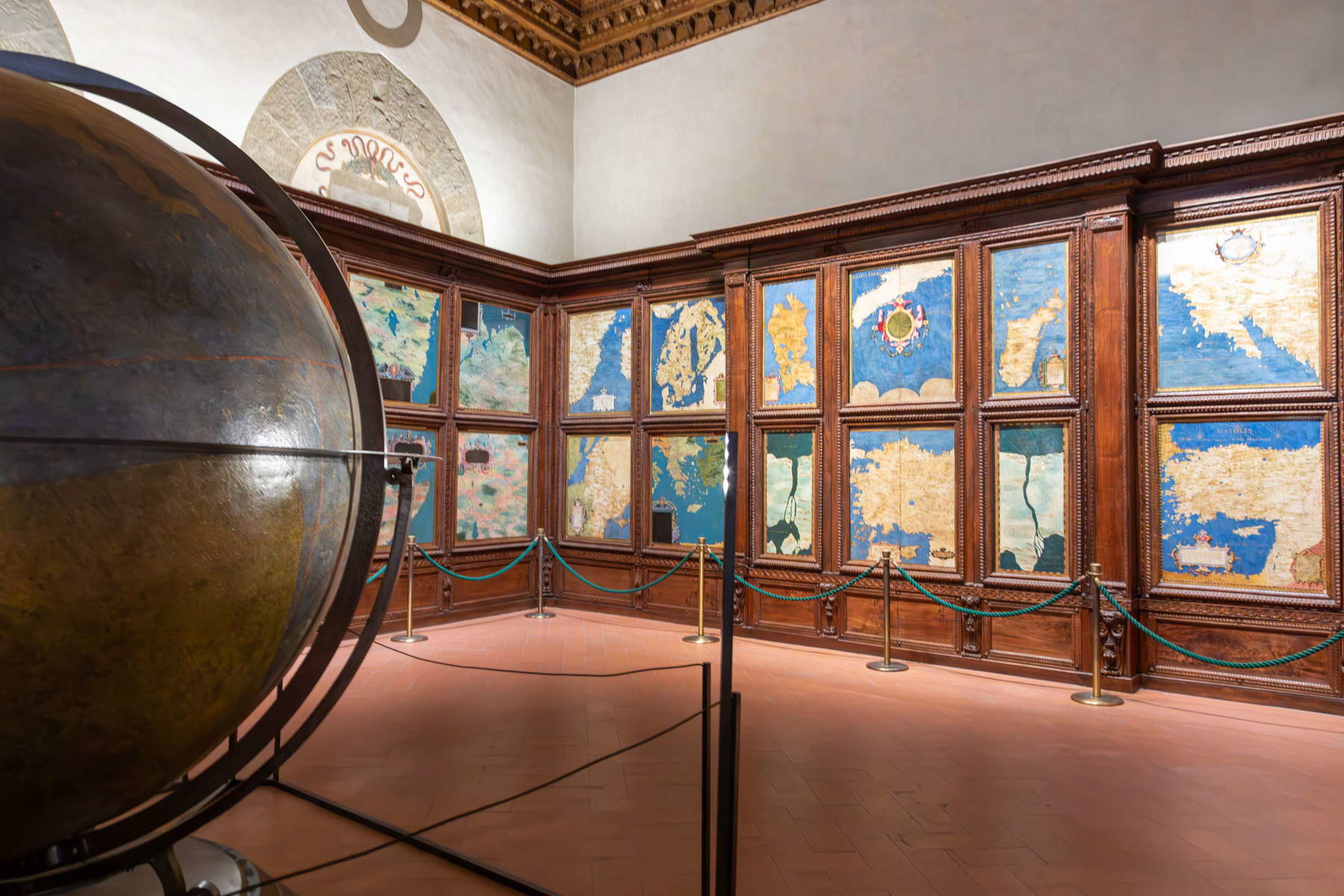Three years of intensive restoration, new technologies, a 3D digital journey and an exceptional historical discovery: the Sala delle Carte Geografiche, part of the Palazzo Vecchio museum in Florence, has been inaugurated after completion of the work. With support from the Friends of Florence Foundation, the renovation has restored vitality to one of the city’s most fascinating and visited sites.
The Sala delle Carte Geografiche, also known as the Sala della Guardaroba, underwent a painstaking restoration involving the large globe in the center of the room, the 53 cosmographic maps, and the 13 monumental walnut cabinets made between 1564 and 1571. The result is a perfect balance of ancient craftsmanship and modern technology, with a new LED lighting system and an innovative website that allows interactive digital exploration.
The work, coordinated by the Fine Arts and Factory Service of Palazzo Vecchio and the Culture Department, was made possible thanks to a donation from the Friends of Florence Foundation. The intervention faced a unique complexity: the globe, impossible to move, was restored directly on site, while the maps were repaired in the adjacent Sala della Cancelleria, without interrupting public access to the room.
The maps, painted in oil on panel between 1563 and 1586 by cosmographers Egnazio Danti and Stefano Bonsignori, represent the known world of the 16th century. The cabinets, made by Dionigi di Matteo Nigetti, have been restored while keeping the decorative engravings intact, and the old plexiglass panels have been replaced with state-of-the-art anti-reflective sheets.
The cleaning of the globe, compromised by 19th-century restorations, removed old dark varnishes, bringing back the fine original colors. The maps, on the other hand, required selective interventions to remove damage caused by previous interventions and restore brilliance to the original colors.
The cupboards, intended to store Cosimo I’s precious objects, were restored to optimal legibility conditions. The thirteen imposing walnut closets, intended over time to contain first tapestries and textile artifacts, then precious objects in silver and gold and finally ancient weapons, were made between 1564 and 1571 by Dionigi di Matteo Nigetti. Of the 57 geographical panels planned in the original design, 53 have come down to us. Of these, 30 were created based on the drawings of the Dominican cosmographer Egnazio Danti (1564-1575), while the remainder were completed by his successor, the Olivetan monk Stefano Bonsignori. The two groups are distinguished mainly by the different painting technique adopted by the two artists. Danti’s plates present a style similar to miniature painting on paper or parchment, with outlines, inscriptions and chiaroscuro carefully traced in ink, evoking the appearance of illuminated manuscripts. In contrast, Bonsignori’s use more opaque oil color drafts, recalling the pictorial techniques commonly employed by painters of the time.
The globe’s metal frame, original from the 16th century, has also been restored, revealing engraved details that had long been invisible.

The work on the great globe also revealed an extraordinary historical discovery. Thanks to research and analysis, it was determined that the present globe is no longer the original globe by Egnazio Danti, made between 1564 and 1569, but a complete reconstruction made by cosmographer Matteo Neroni between 1605 and 1613. All that remains of the original globe is the iron structure designed by engineer Antonio Lupicini and, perhaps, part of its internal armature.
Restored using advanced photogrammetric surveying and videoendoscopy techniques, the globe turned out to be a true work of scientific art. The blue lapis lazuli of the seas, the gold lettering, and the ochre and malachite lands have come to life again, albeit marked by time and past restoration.

All restoration work was accompanied by an extensive documentation program, including multispectral photography and both non-destructive and micro-destructive analysis. The globe was documented during the different phases of the restoration through photogrammetric surveys, the creation of 3D models, and internal inspections carried out with a videoendoscope. The latter made it possible to examine in detail the composition of the layers that make up the complex support system of its painted surface.
The restoration of the maps was carried out in the nearby Chancery Hall, which is visible to the public, with the paintings removed from the cupboard doors and repositioned after the interventions were completed. The wooden supports of the paintings were generally in good condition, but the works presented problems related to painting technique. In particular, the Bonsignori panels showed signs of color slippage and corrugation, as well as alterations in the colors of the marine areas. The effects of previous restorations were evident, with aggressive cleaning that had damaged the painting, consolidations that had permanently stained some surfaces, and a deterioration of the materials used, including yellowing of the protective varnishes and modification of the original retouches.
The goal of the restoration was to improve the legibility of the depictions by selectively working to remove or thin previous restoration materials and by pictorially supplementing the gaps and wear visible due to cleaning. Thanks to this intervention, it was possible to restore the original chromatic values, such as the intense lapis lazuli blue of the seas in Danti’s panels, and the brilliance of the tonal transitions in Bonsignori’s works.
The large globe, which could not be moved elsewhere, was restored on site, with the creation of a construction site that allowed the public to witness the work. Deeply damaged over the centuries and by outdoor displays in the 19th century in the courtyard of the Specola Museum, the globe, disassembled from its iron frame and placed on a wooden base, appeared very dark and almost illegible. Layers of previous restoration covered numerous abrasions and color deficiencies, as well as three large gaps. The cleaning, which took place in two stages, first removed the blanket of repainting, then the black residues of old oil-based retouches, probably dating from nineteenth-century restorations.
At this point, the globe’s original color scheme emerged, refined and precious, though very ragged and worn. The seas, a lapis lazuli blue, were animated by waves and crisscrossed by white sailing ships and sea animals; the inscriptions were in gold, the lands in ochre and malachite, with reliefs lumed and studded with small golden dots. Islands were represented in cinnabar red, as were cities, depicted with small castles or dots. The lines of the geographic grid were perfectly outlined. Because of the preserved condition of the globe, the pictorial additions were done in watercolor, using the technique of tonal lowering, which made it possible to maintain the lightness necessary not to alter the original work, but to restore the legibility of the work.
The external iron support structure was disassembled, restored and then reassembled after the restoration of the painted surface was completed. As a result of this operation, it was possible to confirm that the main iron elements that have come down to us are still the original ones, despite the numerous documented disassemblies and restorations. The cleaning revealed previously hidden details such as engraved or punched graduations and inscriptions that are now again visible.

At the time of the Priors, the room now known as the Hall of Maps did not exist. When Duke Cosimo I de’ Medici settled in the palace, the adjacent rooms were organized to form the Guardaroba quarter, intended to store the court’s property. This space was built later, between 1561 and 1567, under the supervision of Giorgio Vasari, at the request of the duke, who conceived it “with caprice and invention.” The room was to become both the heart of the Guardaroba quarter and an imposing cosmographic room designed to collect and represent all the “things of heaven and earth.”
The project, conceived by Vasari with the help of cosmographer Fra’ Miniato Pitti, remained partially unfinished after Cosimo’s death in 1574. It included 57 geographical panels depicting the territories known at the time in Europe, Africa, Asia and the New World, placed on the doors of large wooden cabinets. In addition to this, the plan included the decoration of the ceiling with allegorical figures of the constellations and the creation of central lacunars from which two sizable globes would descend. The celestial globe, probably never made, was to remain suspended in midair, while the terrestrial globe, still present in the room today, was designed to descend to the floor.
In addition, busts depicting princes and emperors were to be installed above the cabinets and below the ceiling, along with the first three hundred portraits from the Jovian Collection, later transferred to the Uffizi. This ambitious project, aimed at representing in one place all the “things of heaven and earth,” reflected not only Cosimo’s interest in geography, natural and mathematical sciences, but also a celebratory intent. This idea recalled a motto of the duke’s, which, exploiting the play on words with his name and the Greek word “kosmos,” expressed his desire to symbolically embrace the entire universe.
Today, thanks to the new website created by Museo Galileo, anyone can virtually explore the room and its works. The digital model, enhanced by nine videos, allows people to move freely through the virtual environment and admire the details of the maps and globe up close, while also reading texts describing the customs and histories of the populations represented.
The videos include insights into key figures such as Grand Duke Cosimo I de’ Medici, the hall’s creator, and Giorgio Vasari, who designed its architecture. A special focus is on Egnazio Danti and Stefano Bonsignori, authors of the maps, and Antonio Lupicini, who devised the structure of the globe.
 |
| Florence, Sala delle Carte Geografiche reopens restored at Palazzo Vecchio |
Warning: the translation into English of the original Italian article was created using automatic tools. We undertake to review all articles, but we do not guarantee the total absence of inaccuracies in the translation due to the program. You can find the original by clicking on the ITA button. If you find any mistake,please contact us.